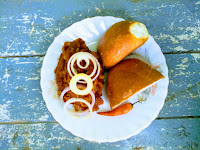Pav bhaji is an Indian street food that consists of soft buns and thick vegetable curry topped with generous amount of butter. Pav means bun and bhaji means curry. Pav bhaji is very easy to prepare and you can easily prepare it at home. For making the curry you can use vegetables like carrots, peas, capsicums, onions, tomatoes and potatoes. Here in this recipe I have used only potatoes. You can use any vegetable of your choice but the curry must be very thick. You can not eat pav bhaji with spoons because you need to tear the bun just like you eat roti(Indian bread) with your fingers and then you have to dip it into the curry and then put it into the mouth.
Pav Bhaji | Buns with Curry
📎Course : Street food
📎Cuisine : Indian
🔪Preparation Time : 15 minutes
♨Cooking Time : 20 minutes
🕞Total : 35 minutes
🍴Servings : 2-3
INGREDIENTS:
- 4 pav buns
- 2 potatoes
- 2 finely chopped red onions
- 2 chopped tomatoes
- 2 finely chopped green chillies
- 1/2 tbsp ginger garlic paste
- 1/2 tsp turmeric powder
- 1/2 tsp cumin powder
- 1/2 tsp coriander powder
- 1/2 tsp red chilli powder
- 1/2 tsp ready-made pav bhaji masala
- 1 tbsp lemon juice
- 2 tbsp cooking oil
- 2 tbsp butter + extra butter for serving
METHOD:
- Boil potatoes. Peel and mash it properly.
- In a pan heat oil.
- Add chopped onions and ginger garlic paste. Fry till translucent.
- Add chopped tomatoes and cook until oil separates.
- Add chopped green chillies.
- Add turmeric powder, cumin powder, coriander powder and red chilli powder.
- Add salt and mix well.
- Add mashed potatoes. Mix everything well.
- Squeeze lemon juice.
- Add ready-made pav bhaji masala. Mix well.
- Add 2 tbsp butter. Mix well and remove from heat. Now the bhaji or the curry is ready to serve.
- Cut buns into halves.
- Heat a nonstick pan or tava.
- Add some butter.
- On medium heat shallow fry buns.
- Serve buns with curry topped with extra butter and sliced onions.

Fans of NFL underdog teams, for instance, will prefer to wager on their teams at even odds than to wager on the favorite, whether or not the wager is $5 or $50. Gamblers might exhibit quantity of|numerous|a selection of} cognitive and motivational biases that distort the perceived odds of occasions and that affect their preferences for gambles. Gloria Mundi, or The Devil addressing the sun, a cartoon showing the British politician Charles James Fox standing on a roulette wheel perched atop a globe showing England and continental Europe. The implication is that his penniless state, indicated by turned-out pockets, 카지노 사이트 end result of|as a result of} of} playing.
ReplyDelete